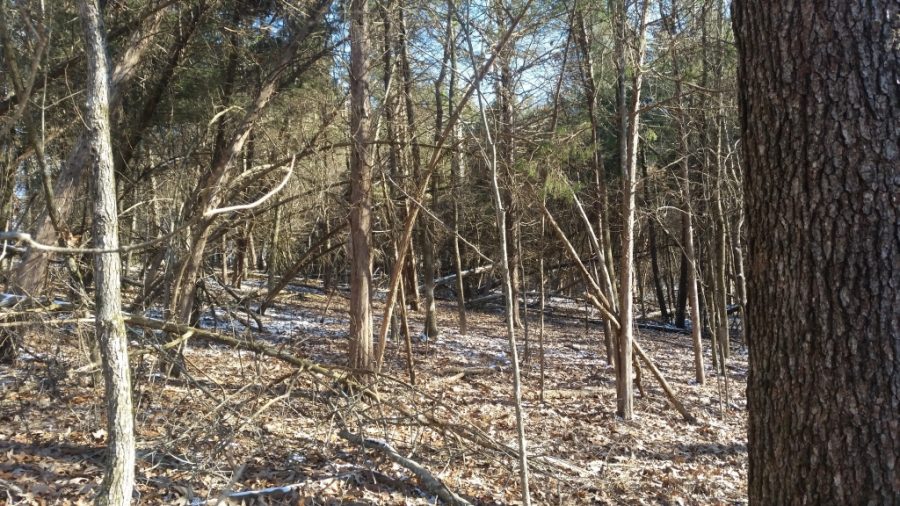Still Just as Mysterious, the Legend of Bigfoot Continues
January 9, 2017

Can you find Bigfoot? photo by Donnie Rand
The sun rose high above the California sky on Oct. 20, 1967. Two filmmakers, Roger Patterson and Robert Gimlin, set out on that clear afternoon to film some scenes in nature and search for an elusive creature known as Sasquatch.
On horseback, armed with a rifle and a video camera, the two made their way across the valley known as Bluff Creek. After an entire morning of riding, they finally spotted something in the early afternoon — a figure with silvery-reddish brown hair crouched by a stream in front of a tree stump.
The horses reared up and neighed in fright. Patterson and Gimlin dismounted quickly and approached the bank. Patterson hastily began recording the figure as it began to exit the scene, and Gimlin reached for his rifle.
He made so much noise and his horse caused such a stir that the creature turned to look over its shoulder, almost directly into Patterson’s camera. Thus, Patterson and Gimlin obtained what many consider the definitive piece of evidence to prove Bigfoot’s existence.
For many, that video footage, filmed 50 years ago, started the Bigfoot (Sasquatch) phenomenon, resulting in a spike of reported Bigfoot sightings in the ’70s and ’80s.
This was not, however, the birth of the Sasquatch legend. In Native American culture, there have been many tales of “wild men” roaming the woods of North America. Granted many of these stories were told to prevent young children from wandering away, but antique cave paintings show that Native Americans documented actual sightings of these “wild men.”
Over many years, these creatures have been called many names. Bigfoot, Grass Man, Sasquatch, Swamp Ape, and Wood Booger are just a few. These creatures are typically reported to be seen in dense forests or swamps across North America, with the Pacific Northwest being the most popular hot spot.
According to Dr. Jeff Meldrum, an anatomy and anthropology professor at Idaho University, “Sasquatch have adapted to varied forest types across the continent.” They allegedly live in areas abundant with deer, fish or berries – the assumed usual diet for the creature.
Depending on the source, one can find many different interpretations of what a Sasquatch looks like. Some claim they have dome-shaped heads and reddish-brown fur, and others argue they have flat faces and a charcoal-black hide.
The most accepted description of a Bigfoot’s appearance can be found in Meldrum’s “Sasquatch Field Guide”: “A Sasquatch’s distinguishing features are ears (hidden) side of head, flat face, broad shoulders, long limbs, high crotch.”
The guide describes Sasquatch typically standing from 7-10 feet tall, weighing 600-1,000 pounds, and having a variety of hair colors. Black, brown, blonde or white would not be uncommon.
Over the past half century many new believers in Bigfoot have surfaced. An increased number of sightings has resulted, along with increased numbers of believers.
Chuck Klineman, a longtime believer, said, “There’s just too many witnesses. How can all of them be hoaxing? Has to be some truth to it.”
Klineman, a believer for as long as he can remember, thinks the Patterson-Gimlin film is the most definitive evidence, along with the amount of unexplored land across the continent.
On the other hand, Deborah Walters thinks the phenomenon has gone a little too far. She believes the P-G film has inspired tricksters to become sneakier with their alleged sightings. Walters said the P-G film is a massive scam.
She said, “It’s pretty suspicious that they just happened to be in the right place at the right time.”
Although she smeared the Patterson-Gimlin film, Walters doesn’t completely disregard the possibility of an ape-like creature inhabiting North America. She said, “If the woods can sustain a bear, then an ape would probably be fine.”
As for the scientific community, they firmly state that Bigfoot has as much credibility as a fairy tale.
In an online interview, Ranae Holland, a research biologist and co-host of the Animal Planet television show “Finding Bigfoot,” said, “I would love for a Bigfoot-type creature to exist, but I do not believe, as there is no tangible, scientific, peer-reviewed data to support that Bigfoot is a biological undiscovered species.”
Holland is known as the “Finding Bigfoot” team skeptic and often serves as the most “logical” mind on the show. Although she doesn’t consider herself a believer, she still enjoys the idea of Bigfoot.
The legend of Sasquatch has been a popular topic of debate for decades. With the discovery of the P-G film nearly 40 years ago, the debate has magnified. With no physical evidence, such as a body or hair sample, the result is still inconclusive – yet people won’t put it to rest. Even though Sasquatch is such a mystery, there are many people who dedicate their lives to the study of the supposed species.
When asked why so many people are intrigued and inspired by the possibility of Bigfoot’s existence, Holland said, “For the same reason it fascinates me. I’m curious to what these witnesses are actually experiencing. Despite no tangible, scientific proof of its existence, thousands of people per year claim to have encountered a Bigfoot. I believe it speaks to the human psyche and the mystery of the unknown.”
A YouTube video showing the famous Patterson-Gimlin film. The creature shows up at the 2:40 mark.
https://www.youtube.com/watch?v=OBTUQI60yqQ

